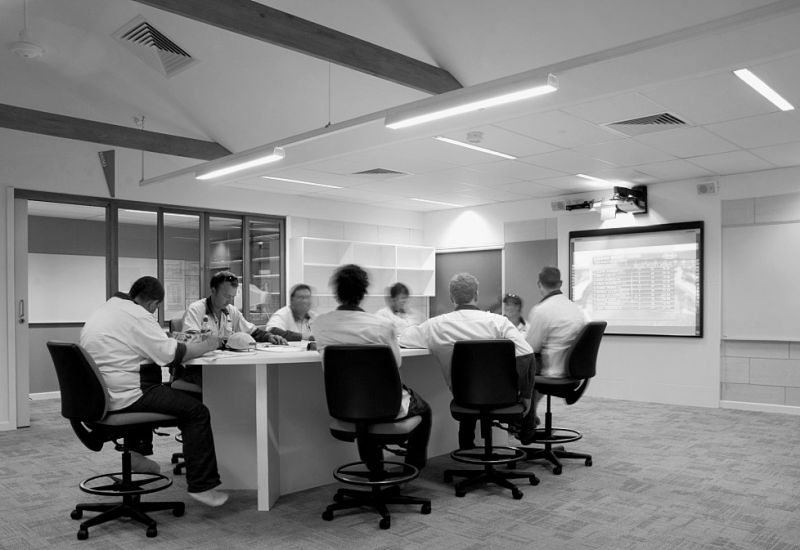Facilitate Process Reliability and Efficiency

The focus of our blog is how the physical workplace can help to make people work more effectively and productively as individuals. But work is more commonly about a chain of processes carried out by a number of individuals. Improving individual productivity delivers only a small benefit compared to improving the process chain. For example, when an individual completes their work and passes it on to the next person, this is where the mistakes happen, and time is wasted. This transition is called "Hand-off" and the time lost during each hand-off can exceed the time it takes to complete a task by a factor of 10. According to thought leader in process engineering and founder of Business Excellence Consulting, Mark Rehn states that by reducing the number of hand-offs or improving the hand-off process, an organisation can reduce operating cost by up to 30% while increasing the quality and consistency of the outcomes.
The focus of our blog is how the physical workplace can help to make people work more effectively and productively as individuals. But work is more commonly about a chain of processes carried out by a number of individuals. Improving individual productivity delivers only a small benefit compared to improving the process chain. For example, when an individual completes their work and passes it on to the next person, this is where the mistakes happen, and time is wasted. This transition is called "Hand-off" and the time lost during each hand-off can exceed the time it takes to complete a task by a factor of 10. According to thought leader in process engineering and founder of Business Excellence Consulting, Mark Rehn states that by reducing the number of hand-offs or improving the hand-off process, and organisation can reduce operating cost by up to 30% while increasing the quality and consistency of the outcomes.
The physical workplace can improve the hand-off process by reducing the risk of mistakes and wasted time they may cause. Through introduction of new technologies, hand-offs can be eliminated altogether.
Simple examples of hand-off include changes of workers between shifts, or where teams are working on different parts of a single product or service. Within an emergency department of a hospital where process reliability and efficiency is non negotiable, the physical environment plays a critical role during hand-off, by making people, process and information explicit, intuitive and transparent. In such environments, hand-off protocols are very explicit, and there are many visual devices to make it intuitive. Briefing takes place at a stand-up bench between the two people, to speed the process, and patient/consultant details are displayed at that point to ensure that no information is lost or overlooked at that critical time.
With increasing levels of automation, and mobile electronic clouds, hand-offs are becoming faster and less prone to error, but with the increased level of mobility and flexible work strategies the physical environment plays an ever important role.
In most businesses, processes have tended to evolve in an as-hoc manner over many years €“ without the benefit of any formal methodology for design or handoff. In the modern world of rapidly changing customer requirements this is no longer efficient or reliable.
Possible ways to improve process efficiency and reliability of any repetitive process chain through workplace environment include:
- Group teams according to process rather than status, role or function. Reinforce physical and visual linkages between process teams.
- For critical processes group people closely together as possible to reduce head to head distances which will enable eavesdropping, speed communication and identify risks earlier.
- Enable each group to establish its own identity. Make each process group responsible for identifying and implementing process improvements.
- Provide opportunities for people to celebrate achievements, suggest improvements in the process or highlight potential sources of error.
- Make the process hand-off as cognitive and visual as possible, including €˜Visual Performance Management€™ where processes and outcomes can be tracked, monitored and measured visually. The more visual the better, project onto the wall, whiteboards, red flags, or flashing lights. The visual performance information must be visible from each group work area, and preferably at an intersection in-between two or more process groups.
- Provide stand-up touch down benches for handoff of the most critical processes. Standup meetings tend to be faster, more direct and as people are shoulder to shoulder, communication is more open and transparent.
- Make supervisors and mentors visible and accessible directly adjacent to the handoff bench.
- Facilitate information exchange through real time visual medium, graphics, posters, magnetic walls or pinboards.
Case Study:
Resource Architecture has developed a design guideline for the design of emergency incident management centres based on the AIIMES process and communication protocols. A pilot project was implemented in Heywood Victoria for the Department of Environment and Primary Industries. The entire space was designed around the AIIMS process and communication protocols, making emergency management explicit and intuitive. The Key decision/handoff space being the stand-up round meeting table within the operations room, with generous circulation and maximum Visual Performance Management tools. The measured outcome included a 42% increase in the speed and quality of decisions.


